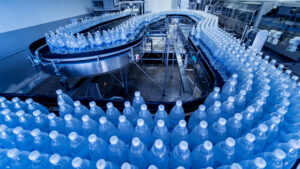This story was originally published by Grist. Sign up for Grist’s weekly newsletter here.
By Joseph Winters, Grist
At this point, it’s common knowledge that bottled water contains microplastics — fragments of the insidious material that can be as small as a bacterial cell. But the problem is much worse than previously known: It turns out that bottled water harbors hundreds of thousands of even tinier pieces of the stuff.
A paper published Monday used a novel technique to analyze one-liter samples of bottled water for plastic granules, going down to just 50 to 100 nanometers in length — roughly the width of a virus. They found nearly a quarter of a million of these tiny particles per liter, about 10 to 100 times more than previously published estimates.
“We’ve opened up a whole new world,” Wei Min, one of the paper’s authors and a chemistry professor at Columbia University, told Grist. Until now, scientists lacked a quick and efficient way to identify nanoplastics, hindering research on their health and environmental impacts.
To conduct their analysis, researchers at Columbia and Rutgers universities filtered bottled water from three different brands through an ultrafine membrane. They then shone two lasers, calibrated to recognize the chemical bonds binding the nanoplastic particles, onto the membrane. Then it was a simple matter of counting all the different particles of plastic. They estimated that a typical one-liter bottle contains 240,000 of them.
Sherri Mason, an associate research professor at Penn State Erie who studies microplastics but was not involved in the new research, called the technique “groundbreaking.”
”I was blown away,” she told Grist. “It’s just really good.”

What’s more, the researchers were able to differentiate between types of nanoplastic. To their surprise, most of the particles were not polyethylene terephthalate, or PET — the material most water bottles are made of. Rather, they found more particles of polyamide (a type of nylon) and polystyrene, suggesting that the pollutants are, in a bit of irony, getting into bottled water as a result of the filling and purification process.
Polyamide also made up the bulk of the contamination by mass for two of the bottled water brands; the third brand showed a higher level of PET.
The findings have significant implications for human health, since nanoplastics are small enough to pass through the gastrointestinal tract and lungs. After entering the bloodstream, they can lodge in the heart and brain, and can even cross through the placenta to infiltrate unborn babies. It’s not yet clear how the particles impact the body, but toxicologists worry that they could leach chemicals or release pathogens that they picked up while floating around in the environment. Some research suggests potential damage to DNA and the brain, as well as to the immune, reproductive and nervous systems.
“We know we’re getting exposed, but we don’t know the toxicity of the exposures,” said Beizhan Yan, another of the paper’s co-authors and an environmental chemist at Columbia University. He called for further collaboration with toxicologists and public health researchers to better characterize the risks. For now, he said he opts for tap water whenever possible; it tends to have less plastic contamination.
Wei sees a handful of promising directions for further research. First, his team could expand the number of plastic polymers it can identify using the laser-microscope technique; their most recent paper only looked at seven. They could also look for nanoplastics in other places, like packaged food or wastewater from washing machines, and improve the technology to detect even smaller particles.
“Fifty to 100 nanometers is our current detection limit, but that’s not a hard stop,” Wei said.
Mason said the research should inspire action from U.S. policymakers, who have the power to limit plastic production by supporting the Break Free From Plastic Pollution Act — a federal bill that was reintroduced in Congress for the third time last October — or by endorsing plastic reduction as part of the United Nations’ global plastics treaty.
“I don’t want a plasticized world,” she said. “We need to make it clear to our representatives that we need to chart a new path forward.”
This article originally appeared in Grist at https://grist.org/science/bottled-water-nanoplastics-microplastics/.
Grist is a nonprofit, independent media organization dedicated to telling stories of climate solutions and a just future. Learn more at Grist.org.
Sign up for The Invading Sea newsletter by visiting here. If you are interested in submitting an opinion piece to The Invading Sea, email Editor Nathan Crabbe at ncrabbe@fau.edu.



